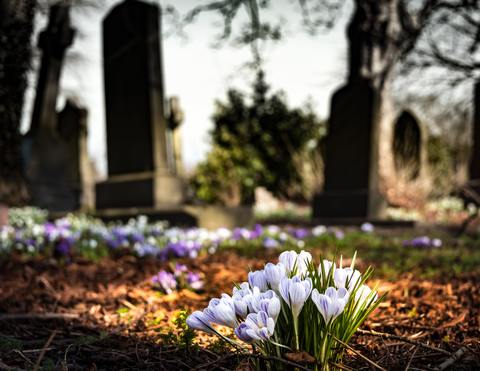
Scattering the ashes of a loved one can often lack the finality or sense of permanence we receive from funeral sites and cemeteries. For many people, the decision to keep cremains at home is an easy one, but for others, choosing a final resting place can be a more delicate task. What should one do if they don’t want to keep ashes in their home? Where do you put ashes in a cemetery? In most instances, people aren’t aware of all the memorial options available to them once a loved one has been cremated. However, there are a variety of options to choose from for memorializing a loved one’s ashes. In this article, we examine the many places your loved one’s cremated ashes can go, to help make the decision a little bit easier.
Columbarium
In many cemeteries, a columbarium is a designated place of respect and storage for cinerary urns. Unlike mausoleums, columbaria are usually above-ground and composed of small wall spaces to store multiple urns. Every niche you see in a columbarium is designed to hold a single urn. Much like burial plots, you can purchase a few niches as a group to store multiple urns together. By doing this, you can provide a space for the ashes of loved ones to be stored for generations, and a space to collectively grieve those you have lost. At a columbarium, urns are usually accompanied by bronze plaques to demark one urn from another. Like a headstone, the plaques will tell a little bit about the person that occupies the space. This cremation niche provides a place for family members and future generations to visit, satisfying the need for permanence that many grieving family members feel all while providing a place for urns at a cemetery. Most facilities offer indoor and outdoor cremation niches, though indoor cremation niches are usually more expensive. Purchasing a cremation niche as needed, or at the time of death, you can expect to pay 20 to 25 percent more over pre-planning your final arrangements. Many people opt to buy their cremation niches in advance to ensure that their families carry out their wishes.
Earth Burial
Now more than ever, cemeteries are responding to the increased popularity of cremation by creating burial plots for cremated remains. These plots are smaller in size and are more affordable than traditional burial plots, making them an attractive option for those that want a permanent memorial, but whose loved ones have wished to be cremated. With a variety of burial urns available, you can create a space to visit your lost loved ones and pay your respects. In addition to a traditional urn, some cemeteries require a burial vault. Much like a burial vault, urn vaults are designed to support the soil and ensure that the urn does not collapse beneath the weight of soil. Instead of six feet, cremated remains are usually buried about three to four feet beneath the surface. Choosing cremation is an easy decision for some, but there are alternatives to traditional burial. There are also ecological burial urns that naturally disintegrate when buried in the ground or in water, returning the deceased to the land and completing the circle of life. Most biodegradable urns are made from recycled paper, salt, sand, corn, palm leaves, tree bark, and other plant-based materials. These types of urns can be placed in more familiar locations, and some urns can even be used to grow trees – allowing new life to grow from the cremains of your lost loved ones. For more information on how biodegradable urns are made or how to decide whether a biodegradable burial is right for you, refer to our helpful planning guide: Green Burials - A Growing Trend.
Pet Ashes
Pet cremation and memorialization is one of the fastest growing death care markets in America. Many people regard their pets as members of the family, a sentiment that is continued well after death. Though combination cemeteries are few and far between, there are cemeteries that are willing to let you be buried with your beloved pet. There are also designated cemeteries for cremated pets, and most operate in conjunction with other pet-related businesses. You can also go the more traditional route of keeping your pet’s urn in your home. If your pet is nearing the end of their life or has recently become deceased, your veterinarian may be able to point you in the direction of a reputable pet aftercare specialist or cremation service. Many vets may also be able to offer cremation services in addition to euthanasia services, so be sure to check with your veterinarian about their recommendations.
Scattering
Some people find the idea of being buried or stored in an urn after they're gone to be unsettling. In this instance, scattering the ashes may be a more suitable option. If burial doesn’t appeal to you, or your loved one wished to be scattered instead, there are also a variety of memorial gardens in which cremated ashes can be poured directly into the ground and covered by grass or vines. In these memorial gardens, you are usually given the option of purchasing a plaque on which you can inscribe your loved one’s name, birthday or a special message. These plaques offer loved ones a place to visit long after the ashes have been returned to the earth. Some people choose to create a place for future generations to visit by installing fountains, granite benches or other artifacts to commemorate the deceased.
If you have any questions about the ideas explored in this article or would like to learn more about the urns and biodegradable solutions that OneWorld Memorials has to offer, please contact us today to speak with an experienced cremation specialist.



